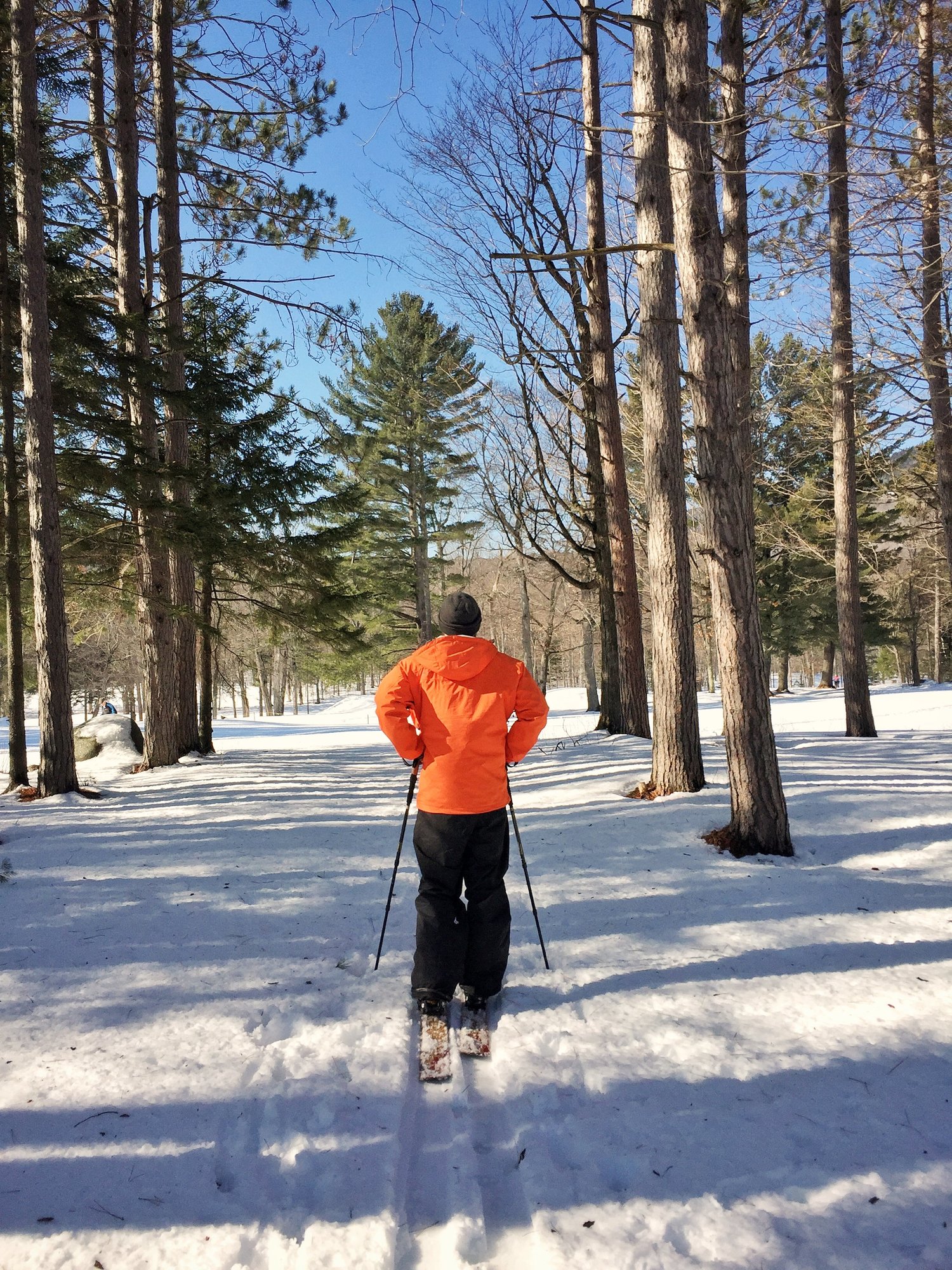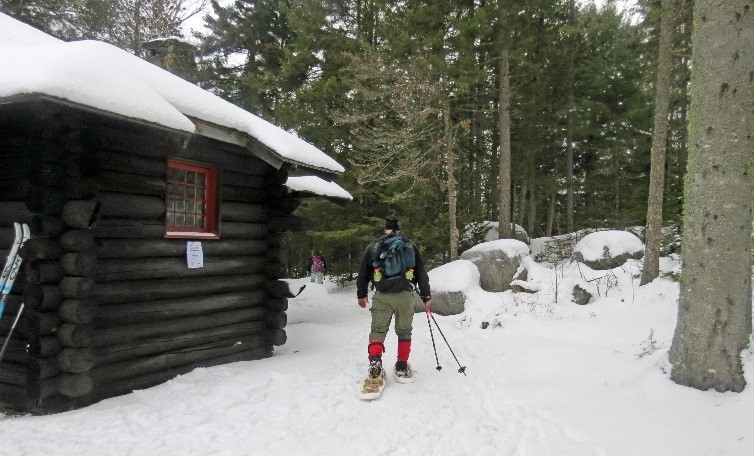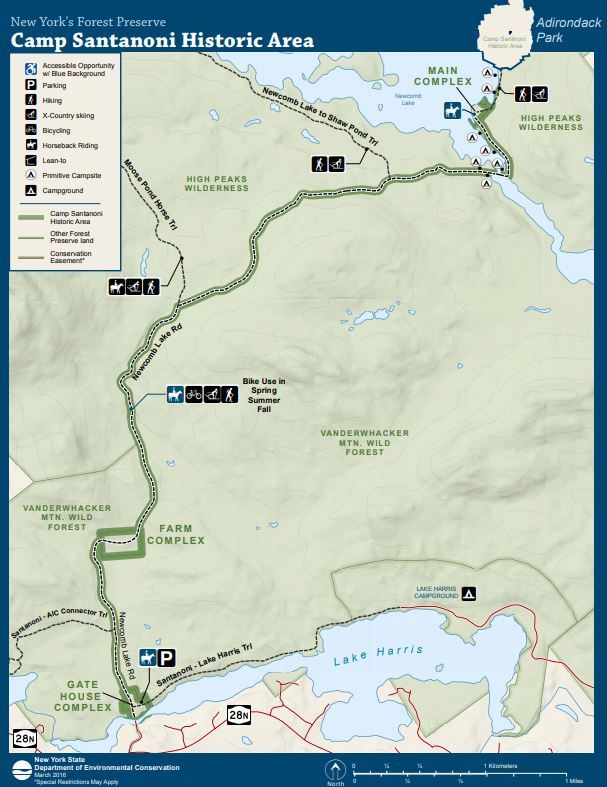|
Have a safe and enjoyable outdoor recreational experience on the lands and waters of the Adirondacks. Properly plan and prepare for your outdoor adventure. Minimize the impact on the mountains and forests, rivers and brooks, ponds and lakes, and the wildlife of the Adirondacks.
Check the Backcountry Information for the Adirondacks web pages for more detailed information on access, outdoor recreation infrastructure, and conditions for those planning to recreate in the Adirondacks. This bulletin provides only the most recent notices.
Emergency Situations: If you get lost or injured, keep calm and stay put. If you have cell service, call the DEC Forest Ranger Emergency Dispatch, 518-891-0235.
Winter is a great time to get outdoors. The cold, crisp air is exhilarating. There are no biting insects, and there are fewer people on the trails. The quiet and solitude are remarkable and most enjoyable. You can find more information on winter hiking safety and what to pack on our website.
Watch a video about winter hiking safety tips.
For more information on winter hiking safety, preparedness, trail conditions, and trip ideas, follow the NYSDEC Adventure Adirondacks group on Facebook.
Plan Ahead and Prepare
Weather forecasts and conditions can and do change quickly. Check the current National Weather Service Forecast, and be prepared for the forecasted conditions, or change your plans.
-
Freezing weather this weekend- pack the proper layers: To layer properly for these conditions; start off with enough layers that you still feel cool while standing. Be sure to
 have a non-cotton base layer to help wick moisture as you start to sweat. This can help keep you dry and keep your temperature better regulated. You will warm up once you start moving. Add and remove layers to keep yourself dry and your body temperature consistent so that you are not shivering or overheating. Wear a winter hat and gloves to keep heat in. Pack a wind resistant jacket and face mask for the summit, as well as extra wool socks to keep your feet dry and warm. have a non-cotton base layer to help wick moisture as you start to sweat. This can help keep you dry and keep your temperature better regulated. You will warm up once you start moving. Add and remove layers to keep yourself dry and your body temperature consistent so that you are not shivering or overheating. Wear a winter hat and gloves to keep heat in. Pack a wind resistant jacket and face mask for the summit, as well as extra wool socks to keep your feet dry and warm.
-
Prevent Hypothermia: Besides layering for the weather conditions, follow these other tips to help prevent hypothermia:
- Carry plenty of food and water. Eat and drink often. Being tired, hungry or dehydrated makes you more susceptible to hypothermia. See Leave No Trace section for how to keep your food from freezing.
- Traveling in snow takes more energy and more time than traveling the same trail on bare ground so take plenty of rests.
- Know the warning signs and call for help/turn around if symptoms start occurring: uncontrollable shivering, exhaustion, slurred speech, confusion, slowed heart rate.
- Always carry a fire starter kit in your emergency kit in case hypothermia symptoms become severe.
Practice Leave No Trace

Follow proper trail etiquette to maintain minimal impact on the environment and the natural resources of the Adirondacks, as well as ensure an enjoyable outdoor experience for all visitors by following the Seven Principles of Leave No Trace.
Did You Know:
-
Winter camping tip; cozy up to your Nalgene. Use a hot water bottle to stay warm for hours. Boil water before bed, pour the hot water in your plastic water bottle (like a Nalgene) and place water bottle in a sock to prevent burning yourself. Snuggle up in your sleeping bag with your water bottle for hours of warmth. In the morning, your water will be perfect temperature for drinking or reheat it for your morning breakfast.
Dispose Waste Properly:
- The practice of packing out your toilet paper leaves the least impact on the area, however, if you are unable to carry it out with you, use small amounts and bury it deep within the soil of your dug cathole. Recent studies show toilet paper decomposes completely if buried correctly in an eight inch deep cathole. Don't have toilet paper? Packed snow makes a great alternative to toilet paper. Digging a correct cathole can be challenging in the winter when the ground is frozen, so plan to carry out all waste with you in the colder months.
Plan Ahead and Prepare:
- Below freezing temperatures can mean frozen snacks and water. Prepare snack bars ahead of time by cutting them into chunks for easy consumption if frozen. Pack snacks in the middle of your pack or inside your jacket, close to your body. Pack Nalgene bottles in thermal cases to avoid freezing. Water in tubes of hydration bladders can freeze quickly. Keep the valve tucked into your jacket, insulate the tubing, and bring an empty water bottle as a failsafe.
General Conditions/Notices
Learn the conditions you will encounter from Adirondack Backcountry Information.
All
-
Road Conditions and Closures: Check before you travel at NY511.
-
Snow Cover: The recent storm has brought plenty of snow to most of the Adirondacks.
- Snow depths range from six to 15 inches across most of the Adirondacks.
- Deeper snows are found in the central Adirondacks and in the higher elevations.
- Snow depths in the southeastern part and the very northeastern corner of the Adirondacks are only two to six inches deep.
- Snow is deeper in the higher elevations; snow is one to three feet deep above 3,000 feet in the High Peaks region.
- The National Weather Service NERFC Snow Page provides maps depicting current snow depths and forecasts.
-
Very Cold Weather: Daytime temperatures are forecast to be in the single digits above zero with nighttime temperatures in the single digits below zero through the weekend for most of the Adirondacks.
- Wind chill factors will be in the double digits below zero due to strong winds.
- Keep skin covered to avoid frostbite.
- Avoid hypothermia:
- Dress properly, stay dry, and add or remove layers to regulate your body temperature.
- Carry plenty of food and water.
- Eat, drink and rest often.
- Being tired, hungry, or dehydrated makes you more susceptible to hypothermia.
-
Be Prepared:
- The sun sets earlier – Always carry a flashlight or headlamp.
- Dress in layers of non-cotton, wicking fabric, and pack extra clothing.
- Wear a hat and gloves.
- Watch a video about winter hiking safety tips.
-
Ice on Waterbodies: Ice has formed on all waters, except fast flowing rivers and streams.
- A layer of water and slush is present on the surface of the ice beneath a cover of
 snow. snow.
- Always check the thickness of ice before traveling across it.
- Avoid ice over running water, near inlets & outlets and near boathouses & docks - especially those with "bubblers" or other ice prevention devices.
- Remember, ice that holds snow may not hold the weight of a person.
-
Be safe on the ice, especially when ice fishing.
-
Seasonal Access Roads: Gates on seasonal access roads on forest preserve and conservation easement lands are closed and locked.
- Motor vehicle use on all seasonal access roads is prohibited until the end of the spring mud season.
- DEC will reopen the roads after they have dried and any needed repairs and maintenance are completed.
Hikers
-
General Information
-
Trail Conditions
- The recent storm has brought plenty of snow to most of the Adirondacks.
- Snowshoes should be worn on all trails where snow depths exceed one foot.
- The use of snowshoes
- Eases travel on snow,
- Prevents “post holing” which can ruin trails, and
- Reduces injuries from trips and falls
- Traveling through snow takes more time and energy than hiking on bare ground – especially when breaking trail through freshly or recently fallen snow.
- Ice may be present under snow or where snow has been blown off trails. Carry trail crampons and use when warranted.
-
Designated Snowmobile Trails:
- Watch and listen for snowmobiles when skiing or snowshoeing on designated snowmobile trails.
- Move off the trail to allow snowmobiles to safely pass.
-
Mountain Summits: Temperatures will be much colder, winds will be stronger, ice will be present, and snow will be deeper. Check the National Weather Service Mountain Point Forecasts for selected summits.
Snowmobilers
-
General Information: Snowmobiling

-
Trails: The recent storm has brought plenty of snow to most of the Adirondacks.
- Many trails are open or will be open this weekend.
- Shallow snow depths in the southeastern Adirondacks may prevent trails from opening in that area.
- Check with local snowmobile clubs to determine status and condition of trails.
-
Safety:
Recent Notices
Notices below reflect recent changes in conditions and recreation infrastructure work that DEC and its partners completed. Check the Backcountry Information for the Adirondacks for ongoing issues and more detailed information.
-
Camp Santanoni Historic Area: DEC and the Friends of Camp Santanoni have scheduled three Camp Santanoni Winter Weekends.
- Cross-country skiers and snowshoers will have access to the historic camp properties to rest, tour the buildings, and view interpretative displays.
- Events will take place:
- Dr. Martin Luther King, Jr. holiday weekend, January 19-21
- Presidents Day holiday weekend, February 16-18
- March 16-17
-
Saranac Lake Wild Forest: DEC contractors have removed the wooden mats from the tracks between Brandy Brook Lane and North Country Community College. This section of the C7B Snowmobile Trail is open, but check local trail conditions before heading out.
- High Peaks Wilderness:
- Recent snow has created good conditions for skiing and snowshoeing in the High Peaks.
- Regulation requires the use of skis or snowshoes on all trails in the High Peaks Wilderness and is strongly encouraged on all trails where snow depths exceed one foot (30 cm). The use of snowshoes:
- Eases travel on snow
- Prevents “post holing” which can ruin trails
- Reduces injuries from trips and falls
- Lake Colden Caretaker reports 37 inches (95 cm) of snow at the stake (2,750 feet; 838 cm elevation) on Wednesday 1/9.
- Snow depths above 3,000 feet (914 m) elevation range from two to four feet (60 to 120 cm).
- Snow depths currently range from 12 to 15 inches (15 to 25 cm) in the lower elevations.
- Lake Colden and Avalanche Lake are crossable. Use caution around inlets and outlets.
Highlighted XC Ski: Camp Santanoni Winter Weekend, Newcomb, NY
Camp Santanoni provides a 9.8-mile round trip cross-country ski excursion. The trail traverses from the Gate Lodge Complex, past the Farm Complex, to the remote lakeside Main Camp Complex, providing a moderate ski and a great opportunity to enjoy the outdoors. For those who don't have their own skis or snowshoes, the Adirondack Interpretive Center provide snowshoes free of charge to visitors at the Gate Lodge.
Trailhead Parking Area: Access the Camp Santanoni Historic Area from the Gate Lodge Parking Area, located on Newcomb Lake Road, off NY Route 28N. (43.9737°N, 74.1650°W).
Skiers and snowshoers are welcome to recreate on the trail and surrounding lands on any day during the winter. However, during the winter weekend events which includes next weekend, January 19-21, cross-country skiers and snowshoers will be able to visit both the Gate Lodge and Main Lodge of Camp Santanoni, view displays about the great camp and take interpretive tours with Adirondack Architectural Heritage (AARCH) staff.
The Artist's Studio, a stone building near the main lodge on the shores of Newcomb Lake, is open as a warming hut during Winter Weekend events. Visitors can warm themselves by the woodstove and enjoy coffee, tea or hot chocolate - you are encouraged to bring your own cup.
In addition to the popular 9.8-mile round trip from the Gate Lodge to the Main Lodge, cross-country skiers and snowshoers are encouraged to take the half mile-trail that connects Camp Santanoni to the nearby Adirondack Interpretive Center's 3.6-mile trail system. The Center's buildings are open from 10 a.m. to 4 p.m. on the Winter Weekends.
Reservations are not required but for more information, contact AARCH at (518) 834-9328
Visit DEC's website for more information on Camp Santanoni Historic Area.
View full Map.

|


 have a non-cotton base layer to help wick moisture as you start to sweat. This can help keep you dry and keep your temperature better regulated. You will warm up once you start moving. Add and remove layers to keep yourself dry and your body temperature consistent so that you are not shivering or overheating. Wear a winter hat and gloves to keep heat in. Pack a wind resistant jacket and face mask for the summit, as well as extra wool socks to keep your feet dry and warm.
have a non-cotton base layer to help wick moisture as you start to sweat. This can help keep you dry and keep your temperature better regulated. You will warm up once you start moving. Add and remove layers to keep yourself dry and your body temperature consistent so that you are not shivering or overheating. Wear a winter hat and gloves to keep heat in. Pack a wind resistant jacket and face mask for the summit, as well as extra wool socks to keep your feet dry and warm.
 snow.
snow.

